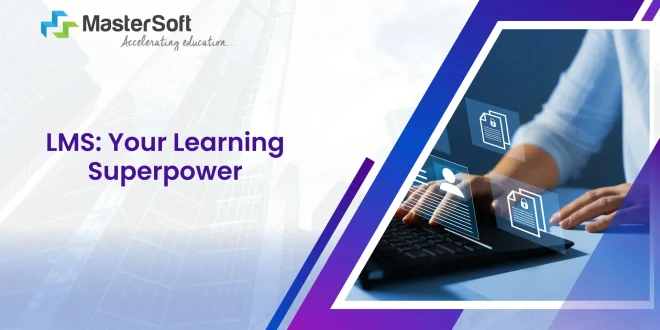In today’s digital age, the way we learn and teach has undergone a significant transformation. Traditional classroom-based education is increasingly being complemented, or even replaced, by online platforms that facilitate learning from anywhere, at any time. A key tool in this shift is the Learning Management System (LMS). In this blog, we’ll explore what an LMS is, its core features, benefits, and how it’s reshaping the educational landscape for institutions, businesses, and learners alike.
1. What is a Learning Management System (LMS)?
A Learning Management System (LMS) is a software application that provides the framework for managing, delivering, and tracking educational content and training programs. It is commonly used by schools, universities, businesses, and other organizations to streamline teaching and learning processes.
An LMS serves as a centralized hub where educators can create and deliver educational content, assess students’ performance, and foster communication and collaboration. For learners, it provides a flexible and engaging platform to access learning materials, complete assignments, and interact with peers and instructors.
2. Key Features of a Learning Management System
LMS platforms come with various features that make the teaching and learning process efficient, flexible, and scalable. Here are the core features that most modern LMS platforms offer:
a. Content Creation and Management
An LMS enables educators to create, upload, and organize educational content such as videos, PDFs, quizzes, and assignments. Educators can also update materials easily, ensuring that students always have access to the latest information.
b. User Management
LMS platforms allow for the creation and management of user accounts for students, instructors, and administrators. Educators can assign roles, monitor individual progress, and manage course enrollments.
c. Course Management
Educators can design and manage courses using an LMS, setting up course structures, modules, and lessons. This allows for both synchronous (live) and asynchronous (self-paced) learning.
d. Assessments and Grading
An LMS supports online assessments, quizzes, and exams. It also provides automated grading systems that give instant feedback to learners and help educators track performance effortlessly.
e. Collaboration Tools
Many LMS platforms come equipped with discussion forums, chat rooms, and video conferencing tools to facilitate communication and collaboration between students and instructors.
f. Reporting and Analytics
LMS platforms provide in-depth reporting and analytics, helping educators track learner engagement, performance, and completion rates. This data is invaluable for identifying areas where students may need additional support.
g. Mobile Learning
Most LMS platforms are accessible on mobile devices, allowing students to learn on-the-go and access educational resources from anywhere.
3. Benefits of Using a Learning Management System
LMS platforms offer numerous benefits for educational institutions, businesses, and learners. Here’s how they are revolutionizing the learning experience:
a. Flexibility and Accessibility
One of the primary advantages of an LMS is the ability to access learning materials anytime and from anywhere. Learners are no longer confined to the four walls of a classroom. This flexibility makes education more accessible to those who may have other commitments or live in remote locations.
b. Cost-Effective
By moving courses online, institutions and businesses can reduce the costs associated with physical classroom spaces, printed materials, and travel. An LMS can significantly cut down on expenses while maintaining or improving the quality of education and training.
c. Personalized Learning
LMS platforms allow educators to personalize learning experiences based on individual needs. Adaptive learning pathways, custom assessments, and tailored content ensure that students can learn at their own pace and receive the support they need.
d. Centralized Data Management
With an LMS, all learning materials, records, and student performance data are stored in one place. This makes it easier to organize, update, and retrieve information, ensuring smooth management for educators and administrators.
e. Scalability
Whether you’re a small school or a large organization with thousands of learners, an LMS can scale with your needs. It’s equally effective for delivering a single course or managing an entire academic curriculum or corporate training program.
f. Enhanced Engagement
LMS platforms often include multimedia tools such as videos, gamification, and interactive assessments that engage students more effectively than traditional learning methods. Gamified features like badges and leaderboards can also motivate learners to complete tasks and improve their performance.
4. LMS in Education
In the realm of education, Learning Management Systems are transforming how students and teachers interact, how lessons are delivered, and how learning is assessed. Here are some ways LMS is being used in schools and universities:
a. Blended Learning
LMS platforms support a blended learning approach, which combines face-to-face classroom instruction with online components. Teachers can assign online homework, host discussions, and provide additional resources, creating a more enriched learning experience.
b. Distance Learning
For schools offering fully online programs or those catering to distance learners, an LMS provides a structured and organized environment for course delivery. It helps students stay on track with coursework, even when they’re learning remotely.
c. Flipped Classrooms
In flipped classrooms, students learn new content at home using online resources available on an LMS, while class time is used for discussions, activities, and problem-solving. This approach encourages more active and engaging classroom interactions.
Read More Here
5. LMS in Corporate Training
LMS platforms are not limited to educational institutions; businesses use them to conduct corporate training and professional development. Here’s how LMS helps companies train their employees:
a. Employee Onboarding
New employees can access training materials, company policies, and compliance courses through an LMS. This allows for consistent onboarding experiences across multiple locations or departments.
b. Skills Development
LMS platforms can offer employees the opportunity to pursue professional development through courses that enhance job-specific skills, leadership abilities, and personal growth.
c. Compliance Training
Many businesses are required to deliver regular compliance training on topics like data privacy, workplace safety, and anti-discrimination policies. An LMS allows for automated course delivery, tracking, and reporting to ensure compliance.
6. Choosing the Right LMS
With numerous LMS platforms available, selecting the right one depends on your institution or business’s unique needs. Here are some factors to consider:
a. Ease of Use
The platform should have an intuitive interface that is easy for both educators and learners to navigate.
b. Customization and Flexibility
Look for an LMS that allows customization of course content, user interfaces, and workflows. The system should be adaptable to your institution’s specific requirements.
Read More Here
c. Integration
The LMS should integrate seamlessly with other tools such as student information systems (SIS), customer relationship management (CRM) software, or third-party apps like Zoom or Google Drive.
d. Support and Training
Ensure that the LMS provider offers ongoing technical support and training to help you maximize the platform’s potential.
7. The Future of LMS
As technology continues to advance, LMS platforms are evolving to incorporate cutting-edge features such as artificial intelligence (AI), virtual reality (VR), and data-driven learning. AI-powered tools can provide personalized learning experiences, while VR can immerse learners in realistic simulations, taking education and training to new heights. Moreover, microlearning and mobile-first design are trends that will continue to grow, catering to learners who prefer short, engaging content that can be accessed on-the-go.
8. Conclusion
A Learning Management System is more than just a tool for organizing content—it’s a complete solution for managing the learning experience, improving engagement, and boosting efficiency. Whether you are an educational institution looking to enhance the learning process or a business aiming to upskill your workforce, an LMS can help you meet your goals in a flexible, scalable, and cost-effective way.
As education and corporate training continue to embrace digital platforms, LMS will play an increasingly central role in the way we learn and teach. Investing in a robust LMS can lead to improved learning outcomes, greater operational efficiency, and a more engaging learning environment for all.
 Diverse Perspectives: Insights & Stories Exploring Ideas, Sharing Knowledge
Diverse Perspectives: Insights & Stories Exploring Ideas, Sharing Knowledge





